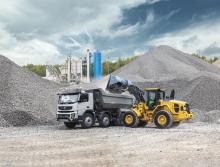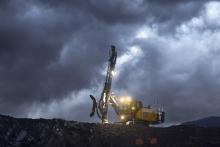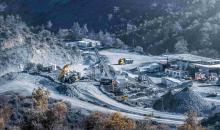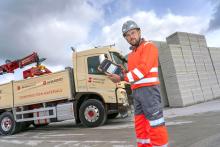Five years after being acquired by US quarrying and mining equipment giant McLanahan, Anaconda Equipment is going from strength to strength, with significant investment in the company's manufacturing headquarters in Ardboe, County Tyrone, Northern Ireland, helping to grow unit sales in a highly competitive global marketplace. Guy Woodford reports
Martin Quinn's passion for Anaconda Equipment (Anaconda) is evident as he talks about how McLanahan's significant investment in the company he co-founded with Alistair Forsyth in 2008 is paying rich dividends.
"It enabled us to get into the crushing plant game, which we'd wanted to do for some time. McLanahan gave us access to quality branded crushing chambers that have been on the Western market for over a century," he explains. "We have also given them a lot of new things around our manufacturing processes. We are paperless, working with iPads, 3D models, and advanced software."

Anaconda's design engineer manager, Jonathan Scott, is alongside Quinn, the company's operations director, as we tour the Ardboe factory. "One of our manufacturing processes that McLanahan was interested in was our welders' use of [digital] tablets," he notes.
"We have come a long way since our first paint shop, which was like a chicken coup!" jokes Quinn. "We have a whole new factory now. The paint shop runs with a full dry-on-dry powder-coating system. We were also the first manufacturer in the industry to use water-based paint with zero [carbon] emissions. It's good to be greener in how we do things. We also benefit from the extra factory space and more production capacity McLanhan's investment has given us."
McLanahan, a six-generation family business, began its partnership with Anaconda in 2017 to distribute and sell the latter's line of mobile track equipment. As the relationship between the two companies progressed, it became clear that their values and business styles were closely aligned, leading to McLanahan's successful acquisition in 2019.
Anaconda has spent the last 16 years developing its extensive mobile-tracked equipment. McLanahan's durable and efficient crushing, scalping, screening, recycling, and conveying equipment is sold through a global dealer network. In the past 16 years, Anaconda has sold over 1,500 units in more than 50 countries across six continents. The business has also expanded operations to sell and distribute parts and equipment from the US.

I ask how much Anaconda production has increased since the major investment in the new Ardboe factory. "We have gone from two to four complete machines a week, so that's double," says Quinn. "We have added the jaw and impact crushers - the J12 and I12. We've also developed a cone crusher, the C12. We launched it at this year's Hillhead [quarrying, construction & recycling exhibition]. We have got one out being tested now." Quinn points to a recently completed C12 plant in the factory's yard. "We recently sold two of them, one to our Australian dealer and another to a US customer. We test all C12s for 500 hours, so we know they're good to go when they leave here."
The direct-drive-technology-inclusive C12 scores highly on accessibility and serviceability. It has ground access, quick setup times, and timed pre-heat as standard.
"We are also developing a larger J14 jaw crusher and a bigger I14 impact crusher, with a full recirculation option," says Quinn. "These will be aimed at mining customers. There's also a new heavy-duty scalper in development. A lot of new stuff. We've also brought in a new engineer to focus on dual-power machines.
"We use various engines in our plants – Caterpillar, Cummins, Deutz, and JCB. We find that different customers prefer certain engines, which we can accommodate. We use Smiley Monroe belting for all our mobile conveyors. They are good people and a great company to work with."
Scott says Anaconda's ambitious plant research and development (R&D) programme benefits from McLanahan's ongoing investment in the Northern Irish manufacturer. "When there's a downturn in the market, you tend to R&D yourself out of it. This will enable us to hit the ground running when the market returns. We've got a lot of experienced engineering talent - around 100-110 years of experience between us."

McLanahan's acquisition of Leicestershire, England-based CMB International (CMB) in 2022 added CMB's RubbleCrusher brand to its stable. Its compact crushers can be mounted on wheels, tracks, or skids and pulled behind a truck. Founded to support the 'zero waste' approach to the construction and demolition recycling industry, RubbleCrusher equipment is ideal for small- to medium-sized crushing and recycling projects that help contribute to a circular economy.
Quinn says Anaconda is manufacturing RubbleCrusher units in Ardboe. "They are getting tight on production space, so we're building around 12 here for delivery to UK customers before Christmas. Because of our facility and capacity, we can take a set of [RubbleCrusher] drawings and build a machine in two weeks.
"It's very significant to be helping RubbleCrusher at present in terms of retaining jobs here. The mobile crushing and screening market is very slow just now. Wars, interest rates, and national elections don't help. I think the first quarter of next year will see demand start to return. The washing plant business is a lot busier. I know McLanahan is very busy on that side of its business."
Cultivating strong partnerships with exclusive dealers throughout the US has been instrumental in placing nearly 1,000 Anaconda units in America over the past decade. Quinn says some of the manufacturer's US dealers have already seen a market resurgence. "We have signed a new dealer in Texas whose first customer order was for eight machines – a cone, a jaw, an impactor, four conveyors and an FTR [feeder] conveyor."
Along with its impressive production capability, another major advantage Anaconda has in seeking to take quick advantage of any pickup in the global crushing and screening market is the wide plant size range it can now offer customers. "Our screeners and scalpers range from 4.5 to 40 tonnes, and our crushers from 6.5 to 70 tonnes," states Scott, who adds that the mobile crushing and screening business is increasingly based on recycled aggregates and other sustainability considerations.
I asked Quinn if McLanahan plans to produce Anaconda machines in the US to reduce lead times for American customers. "I think the cost of manufacturing here is pretty competitive. We can also maintain quality control by keeping things local."
Quinn, who didn't take his GCSEs to take up his first industry job at Dungannon-based Powerscreen in the 1980s, says Anaconda's close links to local County Tyrone schools and colleges enable them to identify and recruit apprentice engineering talent. "We do a Dragons' Den event with a local primary school. It may spark something career-wise a few years later. Young people are very computer-orientated, but a skilled welder can earn quite a lot of money in this industry. With all the health and safety we need to consider now, working in a factory like this is a clean job."
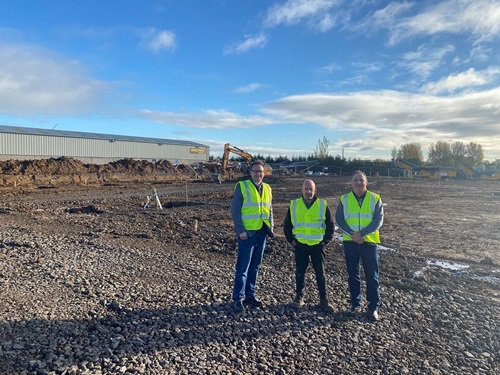
After being asked for more details of his career with Powerscreen, Quinn says: "I worked on the shop floor for a year, and then I was put in the drawing office for eight months. I hated it there and told them that, so I was sent to do plant servicing out of Warrington in Cheshire. I covered the whole of England from there for seven or eight months. I then returned to Northern Ireland before being sent to Greece and Turkey for a while. I then flew out to Denver, Colorado, for two years doing plant installation and maintenance. I covered all of the western side of the US, from Alaska right down to Arizona and across to Kansas, Missouri."
Quinn said following his time in America, he returned to Northern Ireland to drive lorries for another couple of years before returning to Powerscreen. "My uncle worked for them and urged me to rejoin the company. That was around 1995. He got me to work as a factory foreman for two or three years, and then I worked as a subcontractor. There was nothing I didn't build in that period. I was then made a manager at Powerscreen but didn't enjoy that, so I left and started Anaconda [with Alistair Forsyth]."
McLanahan – Europe's marketing & communications strategy lead, Stuart McCrum, is also with us on our factory tour. "Stuart will be producing a series of 'How to' videos: How to start a machine, fix certain things, and do various servicing and maintenance tasks. These will be very useful for some of our dealers and customers," explains Quinn.
A recent addition to the Anaconda and McLanahan – Europe team, McCrum expands on his role: "From a digital perspective, the Anaconda website will be updated, including its dealer network section. We want people to go onto the website and see a global map of where our dealers are and click through to them. There will be a renewed focus on the company's social media and marketing as a whole."
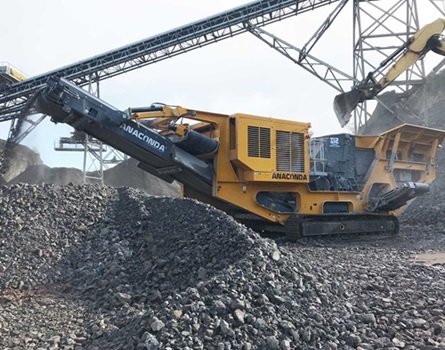
Quinn says Anaconda also uses Epicor, an enterprise resource planning system (ERPS) that helps businesses plan production and manage inventory. "We've been using it for over a year and are starting to see its benefits in just-in-time production. Epicor is a good planning aid that tells us what stock to carry. We don't have any more parts shortages. It's been a game changer."
Are smart glasses, eye or head-worn wearable computers, or other advanced technology used in Anaconda's Ardboe operation? "The software we are using can be used like that. I've had a demo, and smart glasses will have a place in this industry," says Quinn. "Our software creates a 3D representation of each plant model to help our shop floor team build it by illustrating what part goes where. We also have a health and safety app that the team can fill in [to highlight incidents or concerns]. The experience of our people means that if they see something isn’t being done right during production, they will call it out there and then. The shop floor team also do ‘Tool Box Talks’ at the start of the shift where [manufacturing and assembly] issues are discussed.”
Anaconda Ardboe factory workers work from 8am to 5pm Monday to Thursday, and 8am to 2pm on Fridays. “Welders can get a bit of overtime, but otherwise, we have a single shift Monday to Friday work pattern,” says Quinn. “Everybody pushes hard and tries to do their best. There’s no such thing as ‘No, I can’t do’ or ‘That’s not my job.’”
When we stop to look at a RubbleCrusher screen being welded, Quinn says: “Everything a welder needs for each machine they’re working on is in a kit placed in a storage bin. They don’t need to go looking for anything. Each welder has two iPads—one with a 3D image of the machine they’re working on, with each section of the machine you touch giving you the part number. The other iPad has his machine drawings, a parts list, and a kit checklist.”
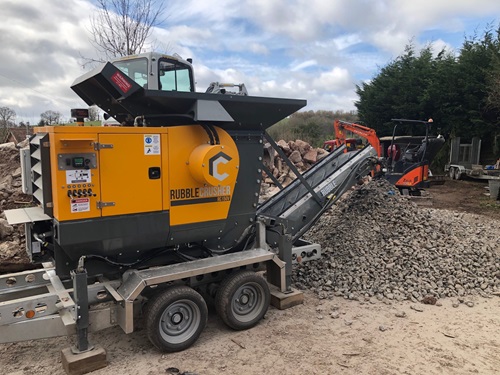
After highlighting the factory’s steel-cutting and sheet-metal folding machines, followed by the shot blasting area and paint shop, Quinn compares the ultra-modern site he works in today with Anaconda’s early production years. “We did everything in this shed here,” he says, pointing at an old nearby structure. “That produced two machines a week, with the paint shop, which, as I said earlier, I called the chicken coup, just behind it.
“Now the factory is future-proofed. We have so much space. For instance, we could install a second paint shop if needed. We have benefited from McLanahan’s experience as a much older company. They see things further down the road than I can. They have been very good at letting us run this factory how we want. And in meetings with them, they always ask, ‘Do you want anything?’ or ‘Do you need anything?’. That is very reassuring.”
After taking in the spacious plant assembly area, we step out into the factory yard. “Most of the finished plants you see here are sold. Three are going to Australia, one to Slovenia, and this other one here is another for Australia, while that cone crusher there is for the US,” says Quinn, pointing at various crushers and screeners.
“They are going to our dealers who sell them to quarries, mines, and one-man-band operations. Each machine you see here has been tested for five hours to ensure no leaks or other issues before being dispatched to customers.
“I just saw on LinkedIn that a dealer had sold a DF410 scalping screen to a customer wanting it to process rubbish in a recycling yard. They had put the plant in as a demo, and the customer liked it and bought it.”
Another uplifting anecdote from Martin Quinn to end our highly insightful and memorable Anaconda factory tour.

